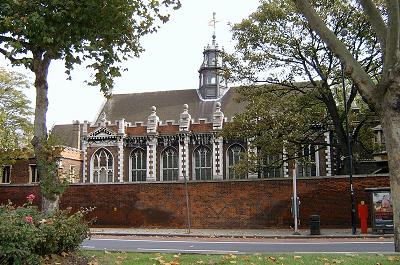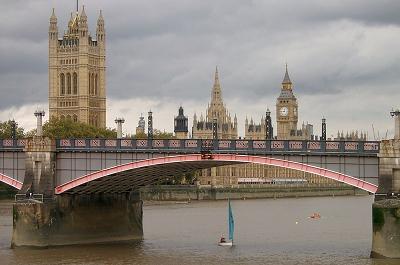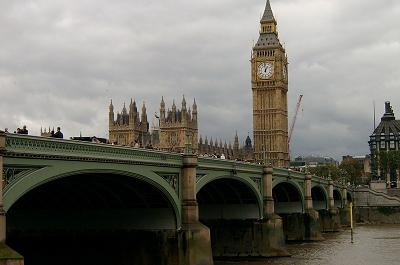Westminster
The view across the river is seen countless times every week on television. I have arrived at the Palace of Westminster.
 Lambeth Palace
Lambeth Palace
Before then let us take a look at the building behind me. Ignored by many of the sightseers it is an important palace in the history of England. Lambeth Palace has been the London residence of the Archbishop of Canterbury since the early 13th century. In fact, it was Stephen Langton who was the first Archbishop to take residence here. You will recall he was the Archbishop caught up in all the chicanery of King John and the Barons in 1215 resulting in the meeting to introduce Magna Carta.
The current resident is Dr.Rowan Williams, leads a very different life to his earlier predecessors. In addition to his responsibilities as the senior Bishop of the Church of England, he also has the senior position of the Anglican Communion around the world.
The palace has been continuously developed over the years, and has had at least two major restoration projects. Firstly after the Civil War when it was almost destroyed by Cromwell’s followers, and secondly following bomb damage during the blitz.
Next along is St Thomas’ Hospital. And no, I have not put the apostrophe in the wrong place. It is meant to be plural, for the hospital is named after two St Thomases. They are St Thomas Becket and St Thomas the Apostle. The hospital was originally founded in Southwark by the monks of Southwark Priory, but moved to this present site in 1871.
I turn back to the major feature. How many people this afternoon are simply sitting on the seats and walls along this stretch of the promenade looking across the water at the familiar architecture. There must be several hundred. It is coming up to four o’clock in the afternoon and we are all waiting for one thing. We look expectantly towards the top of Clock Tower and wait.
The big hand moves to the vertical...
Dum, dum, dum, dum... dah, dah, dah, dah...
Dum, dum, dum, dum... dah, dah, dah, dah...
BONG!
BONG!
BONG!
BONG!
Not many people may know this, but (a) the bell is not the original, and (b) even the bell used now is not perfect.
The first bell was cast on 6th August 1856 by John Warner and Sons of Stockton-on-Tees. It weighed 16 imperial tons, (14.5 metric tonne). The commissioner of works for the new Palace of Westminster was Sir Benjamin Hall, and it is believed that the name “Big Ben” developed from his name.
While being tested, the bell cracked and was no longer able to be used. It was taken down and recast at the famous Whitechapel Bell Foundry on 10th April 1858 and came out as 13.76 tonne. The dimensions are 2.2metres tall, and 2.9metres diameter. It took eighteen hours to pull it up into position. It first chimed in July 1859, and in September guess what? Yes; it cracked again. Fingers were pointed, and in the end the hammer was blamed for being too heavy. The bell was twisted round so that a different part of the bell was struck, and the crack filled. It has worked perfectly well ever since, even if the tone is very slightly off-key. Another one for the trivia buffs, the bell strikes the pitch of “A”.
There are also four “Quarter Bells” in the tower. These bells provide the chimes, and are tuned to the pitch of G sharp; F sharp; E and B. The sequence is known as the Cambridge chimes and is supposedly a variation on a phrase from Handel’s Messiah. There are even words to the chime, derived from Psalm 37,
“All through this hour,
Lord be my guide,
And by Thy power,
No foot shall slide".
The clock is also fascinating. The clock and dials were designed by Augustus Pugin (1812 – 1852). Pugin was a brilliant designer particularly of ecclesiastical buildings. He is a particularly sad case. He died without seeing his work at Westminster completed. His descent into madness culminated in an early death at the young age of just forty years.
The clock faces are 23 feet (7m) in diameter, each supporting 312 pieces of opaque glass. The perimeter of the dials is gilded. At the base of each clock face is the inscription “Domine salvam fac Reginam nostrum Victoriam Primam”, which translates as “O Lord keep safe our Queen Victoria the First.”.
The hour hand is 9 ft (2.7m) long, and the minute hand is 14 ft (4.3m) long. The pendulum is 3.9m long, weighs 300Kg and beats once every 2 seconds. Cast your mind back to those old school physics lessons, measuring the swing of a pendulum. You may remember that the time of the swing is a function of the length of the pendulum and the weight of the pendulum. The guardians of the clock devised an ingenious but simple way of correcting the pendulum. They use a pile of old penny pieces and add or remove them from the base of the pendulum. Adding or removing a penny will change the speed of the clock by 0.4 of a second per day. This is how they keep the clock to such perfect time.
Not quite so ingenious is the winding gear. For all modern technology it still requires winding up by hand three times per week, which takes about one hour each time.
The chimes of Big Ben have rung out across the area, and we can all get up and continue on our way.
Some more quiz trivia. What are the colours of Lambeth and Westminster Bridges, and why? Well, the Palace of Westminster sits between the two bridges, and Lambeth Bridge is predominantly red to represent the covering on the benches in the House of Lords, and Westminster Bridge is mainly green to represent the colour of the benches in the House of Commons.
 Lambeth Bridge
Lambeth Bridge
 Westminster Bridge
Westminster Bridge
Some more quiz trivia. What are the colours of Lambeth and Westminster Bridges, and why? Well, the Palace of Westminster sits between the two bridges, and Lambeth Bridge is predominantly red to represent the covering on the benches in the House of Lords, and Westminster Bridge is mainly green to represent the colour of the benches in the House of Commons.
Westminster Bridge marks the end of the penultimate day. I stop in the middle of the bridge to look back at my path and reflect on the day. It has been a day of highs and lows, starting with the greenery of Richmond and Kew, the romance of the boat race stretch, the descent into the streets of Putney, rising up again to the huge glitzy modern developments signalling a bright future, down again to the waste transfer station, then back up again to the spiritual atmosphere of the Peace Temple before descending to the desolation of Battersea Power Station and then finally being uplifted by the glorious neo-Gothic Palace of Westminster and the unmistakeable chimes of Big Ben.
What would tomorrow bring?
< Previous Page | Next Chapter >